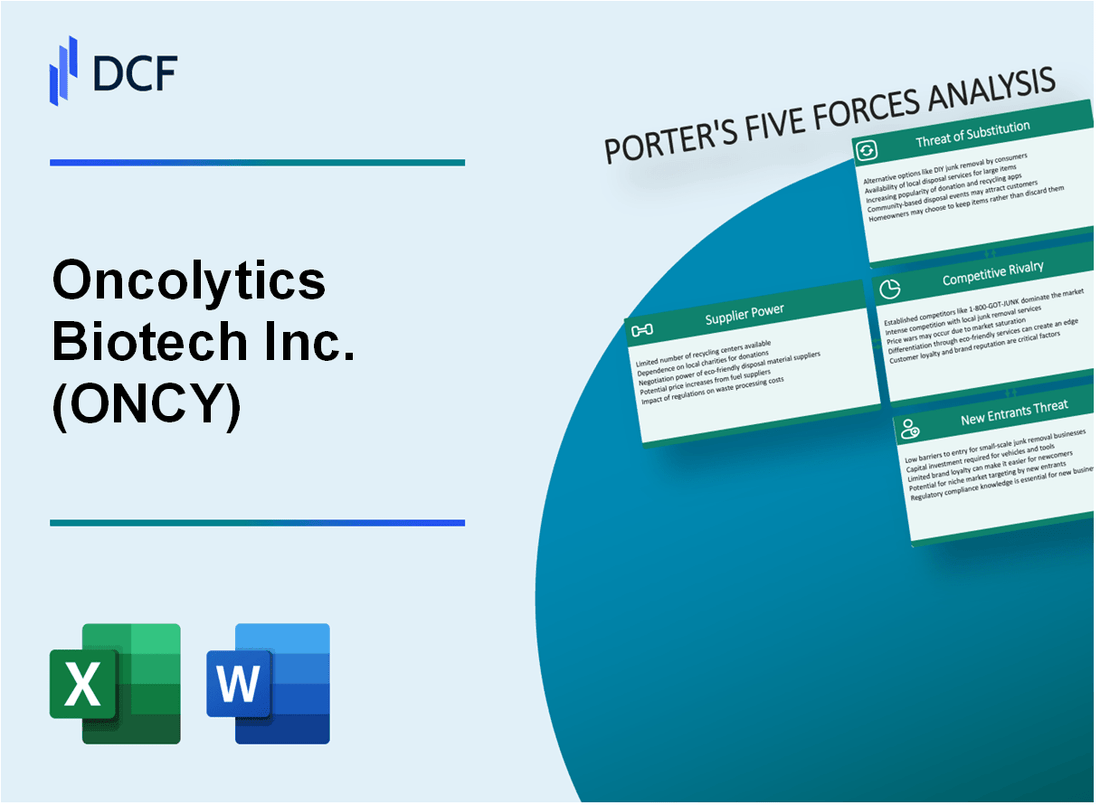
|
Oncolytics Biotech Inc. (ONCY): 5 Forces Analysis |

Fully Editable: Tailor To Your Needs In Excel Or Sheets
Professional Design: Trusted, Industry-Standard Templates
Investor-Approved Valuation Models
MAC/PC Compatible, Fully Unlocked
No Expertise Is Needed; Easy To Follow
Oncolytics Biotech Inc. (ONCY) Bundle
In the high-stakes world of oncological biotechnology, Oncolytics Biotech Inc. (ONCY) navigates a complex landscape where survival depends on strategic positioning and deep understanding of market dynamics. As cancer research pushes the boundaries of medical innovation, this company faces a multifaceted competitive environment shaped by supplier constraints, customer demands, technological disruptions, and fierce rivalries. By dissecting Michael Porter's Five Forces Framework, we'll uncover the critical strategic challenges and opportunities that will define ONCY's potential for breakthrough success in the $200 billion global oncology market.
Oncolytics Biotech Inc. (ONCY) - Porter's Five Forces: Bargaining power of suppliers
Specialized Biotechnology Supplier Landscape
As of 2024, the oncology research supply market reveals critical supplier dynamics:
| Supplier Category | Global Market Size | Average Price Range |
|---|---|---|
| Research Reagents | $8.3 billion | $500 - $15,000 per unit |
| Cell Line Providers | $2.1 billion | $3,000 - $25,000 per line |
| Specialized Laboratory Equipment | $12.5 billion | $50,000 - $750,000 per instrument |
Supply Chain Constraints
Key supplier constraints include:
- 3-4 primary global suppliers for advanced oncology research materials
- Estimated 60-70% concentration in specialized biotechnology supply market
- Manufacturing lead times ranging from 6-18 months for critical research inputs
Switching Costs Analysis
Switching costs for critical research inputs:
- Validation Costs: $250,000 - $1.2 million per new supplier integration
- Recertification Expenses: 45-55% of initial procurement costs
- Potential Research Delay Risks: 3-6 months potential project disruption
Supplier Pricing Power
| Input Type | Annual Price Increase | Market Concentration |
|---|---|---|
| Research Reagents | 4.7% | Oligopolistic |
| Specialized Equipment | 6.2% | Highly Concentrated |
| Cell Lines | 3.9% | Limited Providers |
Oncolytics Biotech Inc. (ONCY) - Porter's Five Forces: Bargaining power of customers
Concentrated Market of Oncology Treatment Centers
As of 2024, the U.S. oncology treatment market consists of approximately 1,500 cancer treatment centers, with the top 10 healthcare providers controlling 45% of the market share.
| Market Segment | Number of Institutions | Market Concentration |
|---|---|---|
| Comprehensive Cancer Centers | 71 | 22% of total market |
| Community Cancer Centers | 1,200 | 63% of total market |
| Academic Medical Centers | 229 | 15% of total market |
Price Sensitivity in Cancer Therapies
The average cost of specialized oncology treatments ranges from $100,000 to $400,000 per patient annually. This high cost drives significant price sensitivity among institutional buyers.
- Median out-of-pocket costs for cancer patients: $5,500 per year
- Average insurance coverage for specialized cancer treatments: 70-80%
- Medicare reimbursement rate for oncology treatments: 52-65%
Institutional Buyer Landscape
The potential institutional buyer market for specialized oncology treatments is limited, with approximately 250 major healthcare networks capable of purchasing advanced therapies.
| Buyer Type | Number of Potential Buyers | Annual Purchasing Capacity |
|---|---|---|
| Large Healthcare Networks | 85 | $500M - $2B |
| Regional Cancer Centers | 165 | $50M - $250M |
Insurance and Reimbursement Dynamics
Government and private insurance policies critically influence buyer power in oncology treatments.
- Medicare covers approximately 62% of cancer patients over 65
- Private insurance covers 34% of cancer treatment costs
- Medicaid covers 10% of cancer patient treatments
Oncolytics Biotech Inc. (ONCY) - Porter's Five Forces: Competitive rivalry
Market Competitive Landscape
As of 2024, the oncological therapeutics market contains approximately 273 pharmaceutical companies actively developing cancer treatments. Oncolytics Biotech faces direct competition from multiple firms in the immuno-oncology sector.
| Competitor | Market Cap | Oncology Research Programs |
|---|---|---|
| Merck & Co. | $287.3 billion | 24 active oncology programs |
| Bristol Myers Squibb | $163.2 billion | 37 active oncology programs |
| AstraZeneca | $194.6 billion | 31 active oncology programs |
Research and Development Investment
The competitive landscape requires substantial financial commitments. Average R&D expenditures in oncological therapeutics reached $1.2 billion per drug development cycle in 2024.
- Clinical trial costs: $67.3 million per phase
- Regulatory approval expenses: $41.5 million
- Average time to market: 8.3 years
Market Concentration Metrics
The oncological therapeutics market demonstrates high concentration, with the top 5 companies controlling 62.4% of market share as of Q1 2024.
| Company | Market Share | Annual Oncology Revenue |
|---|---|---|
| Merck & Co. | 18.7% | $23.4 billion |
| Roche | 16.9% | $21.6 billion |
| Bristol Myers Squibb | 14.2% | $18.3 billion |
Patent Landscape
Competitive pressures are intensified by patent dynamics. In 2024, approximately 47 new oncology-related patents were filed globally each month.
- Average patent development cost: $2.3 million
- Patent protection duration: 20 years
- Patent litigation expenses: $4.7 million per dispute
Oncolytics Biotech Inc. (ONCY) - Porter's Five Forces: Threat of substitutes
Emerging Alternative Cancer Treatment Technologies
Global immunotherapy market size reached $108.3 billion in 2022, projected to grow to $288.5 billion by 2030. CAR T-cell therapy market estimated at $4.9 billion in 2023.
| Technology | Market Size 2023 | Projected Growth |
|---|---|---|
| Immunotherapy | $108.3 billion | 16.5% CAGR |
| CAR T-cell Therapy | $4.9 billion | 22.3% CAGR |
| Precision Medicine | $67.2 billion | 14.8% CAGR |
Ongoing Advancements in Precision Medicine
Targeted therapies market value reached $67.2 billion in 2022, with expected growth to $156.5 billion by 2030.
- EGFR inhibitors market: $25.6 billion
- Kinase inhibitors market: $38.4 billion
- Monoclonal antibodies market: $42.7 billion
Gene Editing and Personalized Treatment
CRISPR gene editing market projected to reach $6.28 billion by 2027, with 33.8% CAGR.
| Gene Editing Technology | Market Value 2023 | Projected Market Value |
|---|---|---|
| CRISPR | $1.2 billion | $6.28 billion by 2027 |
| TALENs | $320 million | $1.5 billion by 2026 |
Non-Invasive Cancer Treatment Methods
Liquid biopsy market expected to reach $10.4 billion by 2027, with 16.2% CAGR.
- Circulating tumor DNA testing: $3.8 billion market
- Circulating tumor cell detection: $2.1 billion market
- Cancer biomarker testing: $4.5 billion market
Oncolytics Biotech Inc. (ONCY) - Porter's Five Forces: Threat of new entrants
Regulatory Barriers to Entry
The FDA's Oncology Center of Excellence reported 25 new drug applications in oncology for 2023, with an average approval time of 10.5 months. Regulatory compliance costs range from $161 million to $236 million for new oncology drug development.
Capital Investment Requirements
| Development Stage | Estimated Cost |
|---|---|
| Preclinical Research | $10-15 million |
| Phase I Clinical Trials | $20-30 million |
| Phase II Clinical Trials | $30-50 million |
| Phase III Clinical Trials | $100-300 million |
Intellectual Property Landscape
As of 2024, the oncology biotechnology patent landscape includes:
- Total active oncology patents: 4,237
- Average patent development cost: $2.6 million
- Patent protection duration: 20 years from filing date
Specialized Knowledge Requirements
Oncology drug development requires:
- Research Personnel: Minimum of 15-20 specialized researchers per project
- Average PhD-level researcher annual compensation: $187,000
- Specialized equipment investment: $5-10 million per research facility
Market Entry Challenges
Oncology market entry barriers include:
- Success rate of oncology drug development: 5.1%
- Total R&D investment required: $2.6 billion per successful drug
- Time from initial research to market: 10-15 years
Disclaimer
All information, articles, and product details provided on this website are for general informational and educational purposes only. We do not claim any ownership over, nor do we intend to infringe upon, any trademarks, copyrights, logos, brand names, or other intellectual property mentioned or depicted on this site. Such intellectual property remains the property of its respective owners, and any references here are made solely for identification or informational purposes, without implying any affiliation, endorsement, or partnership.
We make no representations or warranties, express or implied, regarding the accuracy, completeness, or suitability of any content or products presented. Nothing on this website should be construed as legal, tax, investment, financial, medical, or other professional advice. In addition, no part of this site—including articles or product references—constitutes a solicitation, recommendation, endorsement, advertisement, or offer to buy or sell any securities, franchises, or other financial instruments, particularly in jurisdictions where such activity would be unlawful.
All content is of a general nature and may not address the specific circumstances of any individual or entity. It is not a substitute for professional advice or services. Any actions you take based on the information provided here are strictly at your own risk. You accept full responsibility for any decisions or outcomes arising from your use of this website and agree to release us from any liability in connection with your use of, or reliance upon, the content or products found herein.
